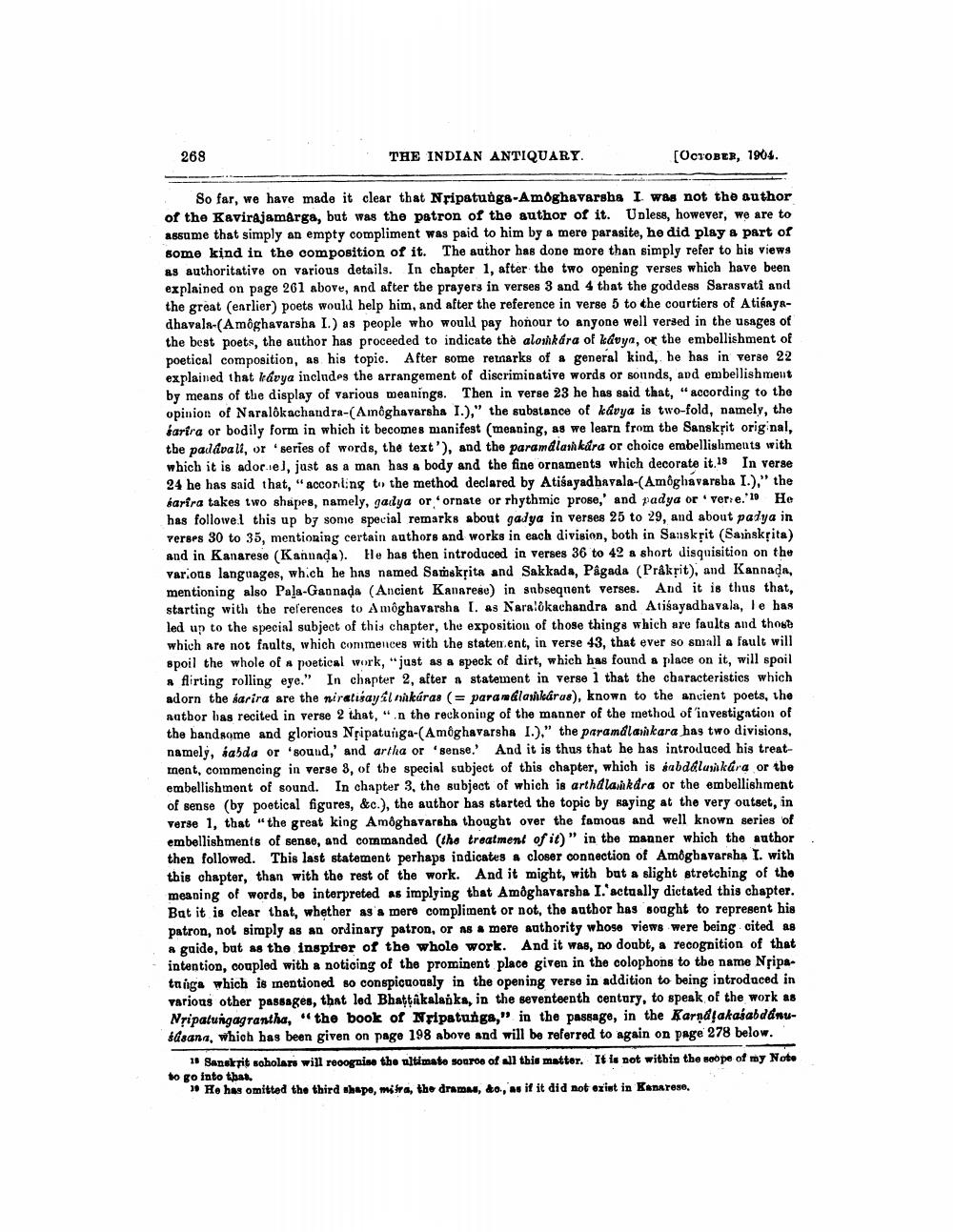________________
268
THE INDIAN ANTIQUARY
[OCTOBER, 1904.
So far, we have made it clear that Nripatungs-Amoghavarsha I was not the author of the Kavirajamarga, but was the patron of the author of it. Unless, however, we are to assume that simply an empty compliment was paid to him by a mere parasite, he did play a part of some kind in the composition of it. The author has done more than simply refer to his views as authoritative on various details. In chapter 1, after the two opening verses which have been explained on page 261 above, and after the prayers in verses 3 and 4 that the goddess Sarasvati and the great (earlier) poets would help him, and after the reference in verse 5 to the courtiers of Atibayadhavala-(Amoghavarsha I.) as people who would pay honour to anyone well versed in the usages of the best poets, the author has proceeded to indicate the aloshkára of kavya, or the embellishment of poetical composition, as his topic. After some remarks of a general kind, he has in verse 22 explained that kávya includes the arrangement of discriminative words or sounds, and embellishment by means of the display of various meanings. Then in verse 23 he has said that, "according to the opinion of Naralokachandra-(Amoghavarsha I.)," the substance of kávya is two-fold, namely, the barira or bodily form in which it becomes manifest (meaning, as we learn from the Sanskrit original, the padávali, or series of words, the text'), and the paramdlarikára or choice embellishments with which it is adorsel, just as a man has a body and the fine ornaments which decorate it.18 In verse 24 he has said that, "acconting to the method declared by Atiśayad bavala-(Amoghavarsba I.)," the barira takes two shapes, namely, gadya or ornate or rhythmic prose,' and padya or verze."10 He has followel this up by some special remarks about gadya in verses 25 to 29, and about padya in verses 30 to 35, mentioning certain authors and works in each division, both in Sanskrit (Sainskrita) and in Kanarese (Kannada). He has then introduced in verses 36 to 42 a short disquisition on the var ons languages, which he has named Samskrita and Sakkada, Pâgada (Prakrit), and Kannada, mentioning also Pala-Gannada (Ancient Kanarese) in subsequent verses. And it is thus that, starting with the references to A môghavarsha I. as Naralókachandra and Atisayad bavala, le has led up to the special subject of this chapter, the exposition of those things which are faults and those which are not faults, which commences with the staten.ent, in verse 43, that ever so small a fault will spoil the whole of poetical work, “just as a speck of dirt, which has found a place on it, will spoil * flirting rolling eye." In chapter 2, after a statement in verse 1 that the characteristics which adorn the sarira are the miratiśayil nikáras (= paramklasikáras), known to the ancient poets, the author has recited in verse 2 that, "in the reckoning of the manner of the method of 'investigation of the bandsome and glorious Nripatunga-(Amoghavarsha I.)," the paramálankara has two divisions, namely, sabda or sound,' and artha or 'sense. And it is thus that he has introduced his treatmnent, commencing in verse 3, of the special subject of this chapter, which is sabd&lusikara or the embellishment of sound. In chapter 3, the subject of which is artha lashkara or the embellishment of sense (by poetical figures, &c.), the author has started the topic by saying at the very outset, in Verse 1, that "the great king Amoghavarsha thought over the famous and well known series of embellishments of sense, and commanded the treatment of it)" in the manner which the author then followed. This last statement perhaps indicates a closer connection of Amoghavarsha I. with this chapter, than with the rest of the work. And it might, with but a slight stretching of the meaning of words, be interpreted as implying that Amôghavarsha I.'actually dictated this chapter. Bat it is clear that, whether as a mere compliment or not, the author has sought to represent his patron, not simply as an ordinary patron, or as a mere authority whose views were being cited as # guide, but as the inspirer of the whole work. And it was, no doubt, a recognition of that intention, coupled with a noticing of the prominent place given in the colophons to the name Nripatanga which is mentioned so conspicuously in the opening verse in addition to being introduced in various other passages, that led Bhattakalanka, in the seventeenth century, to speak of the work as Nipatungagrantha, “the book of Nripatunga," in the passage, in the Karnáļakasabdánususana, which has been given on page 198 above and will be referred to again on page 278 below.
11 Sanskrit scholars will recognise the ultimate souros of all this matter. It is not within the soope of my Note to go into that.
» He has omitted the third shape, mitra, the dramas, do, as if it did not exist in Kanarese.




